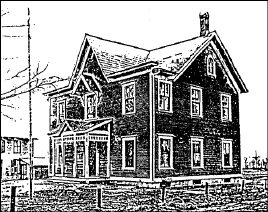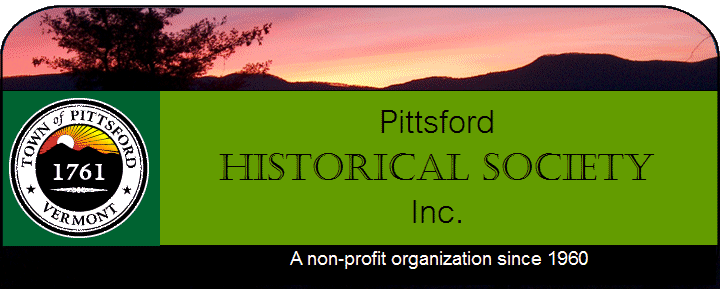Pittsford Historical Society, Inc.
PO Box 423
Pittsford VT 05763 www.pittsfordhistorical.com
802-483-2040
A 501(c) organization since 1961
Fall 2020
** PLEASE NOTE! **
Given the preventive measures against
Covid-19 currently in force, all scheduled events, including the opening
hours of Eaton Hall, are subject to change. We shall do our best to provide
a two-week notice of any changed dates.
Eaton Hall
The Museum will end its regular opening hours in early
November. It remains accessible for visits by arrangement: contact Anne
Pelkey or Steve Belcher (contact info at end of newsletter).
Society Events
The Society meetings planned for the start of the
summer did not take place, because of the Covid-19 health precautions. We
have recently had a cluster of events in the past weeks, trying to catch up.
In order:
September 20:
the 60th Anniversary of the establishment of the Historical
Society.
A quick recap of
the history: The Society was established (without a home) on Sept. 17,
1960. In 1969 the Library offered them exhibit space; in 1981 they bought
Eaton Hall to serve as a museum.
In 1976, commemorating the national Bicentennial, they reprinted
Abiel Caverly’s 1872 History of
Pittsford , with a new index as a supplementary fascicule. In 1980, the
Society published Pittsford Now and
Then, a largely photographic collection of images, offering old and new
views of extant buildings (and photos of houses that had been lost). The
book earned an award from the Vermont Historical Society. In the 1990s, a
committee undertook the challenge of adding to the record of Pittsford’s
history; the result was Pittsford’s
Second Century (1998) that also won an award from the Vermont Historical
Society. In 2009, Peg Armitage put together
Around Pittsford, a collection of
photographs of the town, its people, and their activities over the years.
Throughout this time, the Society undertook a program of recording
the recollections of the older members of the community, and publishing a
series of booklets, the ‘Pittsford Gleanings.’ Members of the Society also
published books, such as Grace Anderson’s
Under the Shadow of Cox Mountain
(recounting the stories of the Revolutionary War era, including the
abduction of Betsey Cox by Native Americans serving the British). Jean
Davies wrote a series of newspaper columns on historical topics, collected
in her book, Neighborly Notes.
Eaton Hall is now a noteworthy museum, displaying artefacts from
Revolutionary times to the present, and still enriched by donations that
become the subject of rotating exhibits.
For the event
itself:
Tents and tables were set up in front of Eaton Hall.
Panels set outside near the Eaton Hall sign showed photos of the founding
members and memorable events. On either side of the entry stairway, computer
displays ran slide-shows of past PHS activities (these were to entertain
people waiting to be admitted to the Museum). There was swag: refrigerator
magnets showing an image of Eaton Hall; T-Shirts, showing Eaton Hall in
front, with the slogan ‘Forget 2020 – Live in the past’ on the back, and
free copies of Pittsford’s Second
Century. There was a cake with an impressive computer-generated picture
of Eaton Hall on the icing.
Anne Pelkey had no respite from the small-group tours
of the interior. Ernie Clerihew acted as gate-keeper. Barb Willis cut the
cake.
September 27:
Visits to the Belcher House
The house was built in 1880 by Martha Wood Belcher, an
artist and art-teacher, and so the house was celebrating its 140th
birthday (in part: a studio was added in 1887). Martha achieved less success
in her time (the challenges to women) than her daughter Hilda Belcher, who
did receive national recognition as a water-color artist in the early years
of the last century. The house conserves the legacy of both these artists,
largely through the efforts of Martha, and continued by the care of later
generations (Hilda’s nieces, Jane and Barbara, were devoted to her).
Visitors were led in small groups through the front ground floor to
see the family portraits (one painting, of Jane Belcher, was stolen from a
Philadelphia museum in 1932, but a ‘preliminary study’ has been preserved),
the early work of Martha Wood, documented from newspaper accounts of the
1870s, and examples of the later work by Hilda Belcher. They also saw
stained glass from two generations of the Belcher family (and two different
companies). The building of the house (the original contract and
specifications, along with receipts, were on display under a tent outside,
with other exhibits intended to entertain/inform those waiting for a tour)
Eva Belden came, carrying a photo of a painting done by Hilda Belcher
in 1926 (‘Hill Child’ or ‘Hungry’). The subject was her mother, Irene Fish,
née Alexander. The painting was widely exhibited until its sale in 1930.
October 4:
PHS Annual Meeting
The meeting was held not in the Fellowship Hall, but in
the nave of the church, where there was enough space to allow social
distancing. There were no refreshments, but masks and sanitizer were on
hand. Ivy Dixon served as gate-keeper, noting names and phone-numbers in
case of the need for contact-tracing.
The Once and Future President Bill Powers presided at a
meeting in which several reports were presented
in absentia. Vice-President Barb
Willis read the President’s Report, the Treasurer’s Report (we are solvent,
despite maintenance expenses on Eaton Hall), and the Curator’s report. Steve
Belcher reported on membership levels (unfortunately declining), and noted
members who have passed away in this year. The proposed slate of new
officers was elected. These reports and the election results will appear in
the Winter Newsletter.
Michael Dwyer then made a presentation on his experiences in using
DNA-tracing services (and he reported the results for several companies
offering the service) to explore genealogy. He illustrated the issues with
pictures of jig-saw puzzle pieces, mostly unconnected. He started with a
family (brother and two sisters) of known 12-generations French-Canadian
ancestry. The brother’s test, for ‘ethnicity’, came back all over the map;
later updates from the company (as their data-base expanded and their
algorithms for matching improved) were more credible. The same proved true
for the two sisters (one of whom had claimed to be ‘more French’ than her
sister). These illustrations included how the numbers associated with
autosomal DNA, the DNA we inherit from both parents, are measured with units
called centomorgans, cMs. The higher the number, the closer relationship
between two people.
He then moved into his own family, trying to find recognition of an
ancestor from the Azores (Portuguese islands in the Atlantic) in his
mother’s genome. It took some effort. The challenge with the ‘ethnicity’
category is that each company uses a different data-base and categorization,
and that – the jig-saw puzzle – they don’t have all the pieces in place. Not
to mention that the term ‘race’ (as in ‘Irish race’, used in the past) isn’t
supported by biology.
Then he moved on to the issue of Surprises: that a bachelor uncle
proved to be the biological father of an otherwise un-related individual
(the genetics of paternity are more reliable than the genetics of ethnicity,
and perhaps more embarrassing). He concluded with the category of
Discoveries, examples of DNA connections to descendants of long-lost
relatives in Ireland. Lastly, Michael gave a passing mention to DNA used for
determining hereditary illnesses. At the conclusion of the presentation
questions followed.
Pittsford Notes
The Covid-19 situation has led to the cancellation of
almost all public events. This is a precaution; on the VT Health Dept.
website mapping, Pittsford is colored in the 1-5 cases shade of pink, and
this assessment has not changed in months. Rutland County has experienced a
small increase in cases (to 131), largely because of people partying in the
Killington area. Vermont, thanks to precautions taken by the state
government, remains one of the places in which the virus has had least
effect: the state death toll has remained at 58 since early August.
Town Activities
There was no Memorial Day celebration, nor a Pittsford
Day (although the Blanchards offered a fireworks display, behind the
Congregational Church). The Village Farm has attempted at least one event,
with music. But the Fire Department’s Haunted House has been cancelled: the
preparation for the events (the essential but invisible part of a show)
entailed too much risk. The Pittsford Haunted House this year will be
visited only by ghosts. However, there will a a Trunk-or-Treat drive by in
the town office space.
Elections
The Vermont Primary in Pittsford (in August) went
smoothly, helped by the layout of the town office: an easy U-turn. Voters
entered one driveway, passed through a tent under which they were given a
clipboard with the ballot of their choice (the primary is a partisan
election; Vermont has not adopted open primaries) and a pencil. They then
parked behind the office, filled out the ballot, and proceeded around the
building to another tent, where they delivered their clipboard and ballot.
The pencil was theirs to keep. Bill Drummond shuttled the clipboards from
one tent to the other, perhaps with assistance.
For the November Election, mail-in ballots have been delivered to all
registered voters. They can be used for early voting, through the simple
operation of delivering them to the Town Clerk’s office (while masked),
while in-person voting (probably under the conditions described above)
remains an option. Mailboxes are being filled with campaign flyers, and
electoral signs are sprouting along the roadsides.
Schools
Lothrop has re-opened. We understand that some 80% of
the students are now attending, in limited hours. Tents are set up on the
grounds along access and egress points, for the temperature checks of
students entering and departing. Students whose parents cannot provide care
in the afternoons are kept in a special program until later in the day.
There has been a decrease in student numbers; grades 3 and 4 are now
combined, as are grades 5-6.
Public Works
The Town was authorized to solicit bids for side-walk
repair along Rte. 7. We have no word on planned work. But some agency did
repaint the street-crossing signs along Rte. 7. On Kendall Hill Rd., they
are working on the railway crossing, stabilizing the bed and adding warning
lights that don’t yet work. This is part of a plan to restore rail service
from Rutland to Burlington.
Nature Notes
Foliage is the seasonal topic, and in certain places
and times it has been spectacular. Elsewhere, the glow has been damped by
rainfall, tearing down the leaves. The roads have not been cluttered with
sight-seeing buses; Vermont relaxed restrictions on visitors, but perhaps
too late for the organization of tours.
And the birds that went north in the spring are coming back south. Vultures,
many hawks, and songbirds of all sorts. Hummingbirds were still reported in
mid-September.

Memberships
Membership in the Society extends over a calendar year. Your dues support
the annual operating expenses of Eaton Hall. Please send your check, payable
to Pittsford Historical Society to: (Welcome to the new Membership Chairman)
Stephen P. Belcher IV. Send dues to
Stephen P. Belcher IV
PO Box 423
Pittsford, VT 05763
We thank you for your continued support.
Name(s)
_______________________________________________________
Street/Apt. #
_______________________________________________________
Town, State and Zip
_______________________________________________________
Please check amount enclosed:
Single $15_____ Family $20 _____ Contributing $25_____
Sponsor $50_____ Life Member $200 (per person) _____
A 501(c)(3) organization
since 1960
 Museum Hours:
Museum Hours:
